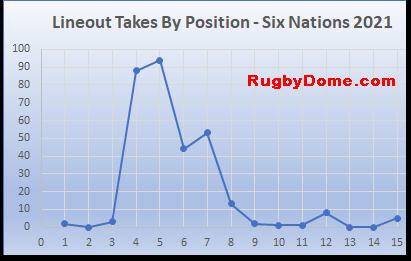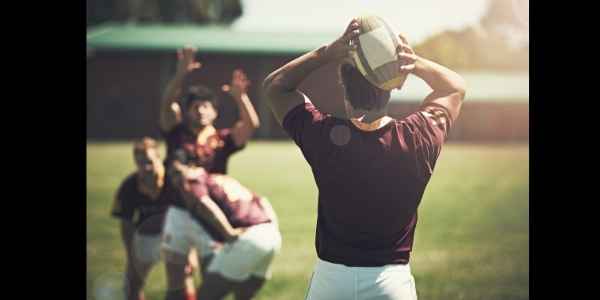Before lifting in the lineout was made legal in 1999, lock forwards traditionally caught most ball. These two players are the tallest in the team, so were most likely to win the ball.
But once lifting was allowed, teams could now hoist smaller forwards high into the air. Now you’ll see other forwards being lifted to catch the lineout ball.
This article uses statistics from the Six Nations tournament in 2021 to answer the question: which position is most likely to be lifted to catch the ball in the lineout.
Lineout Takes By Position
The Six Nations Championship published match statistics in 2021 that included the players catching the ball in lineouts.
I’ve collected the numbers and totaled them by position.
2021 Six Nations Data
Here are the raw numbers from fifteen matches across the tournament.
| Jersey | Position | Lineout Takes | Percentage |
| 1 | Loosehead Prop | 2 | 1% |
| 3 | Tighthead Prop | 3 | 1% |
| 4 | Lock | 88 | 28% |
| 5 | Lock | 94 | 30% |
| 6 | Blindside Flanker | 44 | 14% |
| 7 | Openside Flanker | 53 | 17% |
| 8 | Number Eight | 13 | 4% |
| 9 | Scrumhalf | 2 | 1% |
| 10 | Flyhalf | 1 | 0.3% |
| 11 | Left Wing | 1 | 0.3% |
| 12 | Inside Centre | 8 | 3% |
| 15 | Fullback | 5 | 2% |
2021 Six Nations Graph
Here’s a graph of the same numbers. It’s even clearer that locks still catch most lineouts.

I’ve excluded the positions that didn’t take a single lineout. Of course, that includes the hooker who is throwing in the ball.
Are you surprised to see some backs in the mix? Let’s get that explanation out of the way first.
Backs Who Catch Lineout Ball Usually Aren’t Lifted
Notice that there were fourteen lineout takes by an inside centre, fullback, or wing in this tournament.
These lineout moves usually involve a back catching an overthrow i.e. a ball that is thrown long over the tail of the lineout. The centre or back rushes forward to catch the ball at chest height.
Gael Fickou of France is a specialist at this, and he is responsible for three of those lineout takes.
Scrumhalves
The scrumhalf takes are probably a little different. I don’t remember the specific two in this tournament.
But I expect that the scrumhalf was standing at the front of the lineout and took a short throw. Again, this is a lineout take without being lifted.
Flyhalf?
I’m surprised to see a flyhalf in the mix for one take from the lineout.
But I suspect that this was an overthrow that got messed up and the flyhalf was the first to get to the ball.
Not lifted
The point is that these lineout catches don’t involve the players being lifted.
There are exceptions in rugby. Munster, the Irish province, sometimes throw their tall scrumhalf into the air.
I haven’t seen Conor Murray lose a catch yet. But I also haven’t seen this at international level, let alone the 2021 Six Nations.
As this article is about who gets lifted in the lineout, I’ll move on to the forwards.
Props Aren’t Lifted In The Lineout
The loosehead and tighthead props took a combined total of five lineout catches across the fifteen matches in the Six Nations of 2021.
I’ve never seen a prop lifted in a lineout at international level. They are simply too heavy to lift effectively.
So, how did these props catch five lineout balls?
Lineouts traditionally have a prop forward standing in the first position who will turn and act as a lifted.
A favorite “trick” move is for the hooker to throw the ball low at chest height to the prop who hares off up the sideline.
Who Gets Lifted To Catch The Ball In The Lineout?
Now that we’ve got the non-lifted catches out of the way, let’s answer the main question of this article.
This graph shows the numbers from the 2021 Six Nations.

And this table shows the raw data:
| Jersey | Position | Lineout Takes | Percentage |
| 4 | Lock | 88 | 28% |
| 5 | Lock | 94 | 30% |
| 6 | Blindside Flanker | 44 | 14% |
| 7 | Openside Flanker | 53 | 17% |
| 8 | Number Eight | 13 | 4% |
Locks are the position most often lifted to catch the ball in lineouts. They catch over half of all lineout throws.
Flankers catch nearly a third of lineout ball. Opensides catch slightly more lineouts than blindsides.
Number eights catch a small percentage of lineout ball.
Locks are still lineout specialists
Despite the rule changes that allowed lifting in 1999, locks remain the lineout specialists in rugby.
There is very little difference between four and five in terms of who is catching the ball. The locks are more differentiated in their role in the scrum.
You can read more in our article on the role of locks in rugby.
Flankers aren’t always lifted to catch lineout ball
Note that I didn’t specify that flankers were always being lifted when they catch the ball. The tournaments statistics don’t include whether the catcher was lifted or not.
Flankers sometimes take the over-the-top ball at chest height. It’s unlikely that locks, who are slower, run that move.
Why are blindside flankers and number eights catching the least?
Our article on flankers in rugby explains why the blindside flankers tend to be heavier than the openside.
This is also why blindsides are lifted a little less often. It’s simply that they are heavier.
Number eights tend to be larger than their buddies in the backrow. This is why they have the lowest percentage of catches amongst the second and third row.
There are of course some lighter number eights who are very effective as lineout jumpers. But I’ve noticed that as they get older and a little heavier, they tend to jump less frequently.
More About Lineouts

Check out these articles: